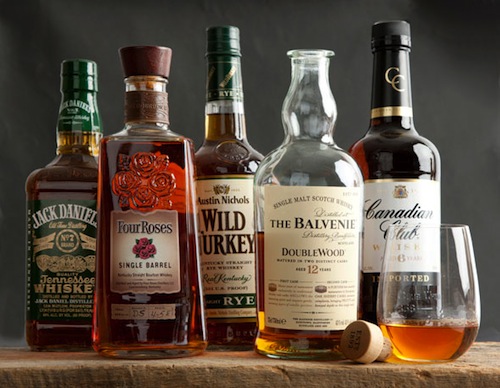 With all the whiskey, scotch and bourbon talk flying around here it’s easy to get confused, so we thought we would take a quick time out to educate you on the world of whiskey. Whiskey, a spirit distilled from malted grain, is an umbrella term encompassing bourbon, rye and scotch among many others. Think of the term “whiskey” as you would “beer”, beer has many different styles such as pilsners and IPA’s just as whiskey has bourbon, rye and scotch.
With all the whiskey, scotch and bourbon talk flying around here it’s easy to get confused, so we thought we would take a quick time out to educate you on the world of whiskey. Whiskey, a spirit distilled from malted grain, is an umbrella term encompassing bourbon, rye and scotch among many others. Think of the term “whiskey” as you would “beer”, beer has many different styles such as pilsners and IPA’s just as whiskey has bourbon, rye and scotch.
To put it very simply, whiskey is just distilled beer. Prior to distillation, the initial steps to making whiskey are similar to making beer with the exception of the use of hops. Gin and vodka are also typically distilled from a “mash” of grain, but what sets whiskey apart is the aging process that takes place in oak barrels after distillation.
Now, here’s a guide to differentiate the four major players of the whiskey family according to Tullamore Dew:
Bourbon – Bourbon is considered “American whiskey”. It must be distilled from at least 51% corn at 160 proof or less and put into a barrel at 125 proof or less, with no additives. It must be aged in a new charred oak barrel for two years and often has a sweet taste with hints of vanilla and caramel.
Rye – Historically older than bourbon, rye was first made by Scotch-Irish distillers in western Pennsylvania in the 1700s. The mash must be at least 51% rye and comes out grainy and spicier than bourbon, with flavors including cinnamon and cloves.
Scotch Whiskey – Unsurprisingly, scotch whiskey must be distilled in Scotland. It is distilled twice, sometimes three times and aged in oak casks for a minimum of three years. Almost all scotch whiskeys are made from 100% malted barley. Each region of Scotland yields a different flavor profile but you can expect a dry, smoky taste from scotch whiskey.
Irish Whiskey – Irish whiskey is a broad term but Irish whiskeys are typically rounder, lighter, and have more fruit tones than American whiskeys.

